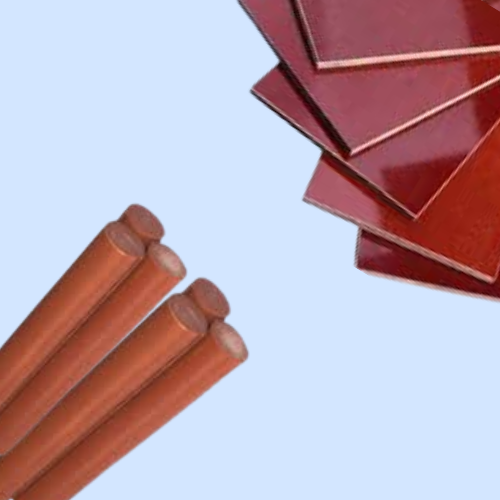What are Phenolic cotton sheets and rods (Hylam _ Bakelite)?
Ever wondered why certain industrial components last for decades without cracking, warping, or losing shape? The secret often lies in the materials used, and phenolic cotton sheets and rods, widely known as Hylam or Bakelite, are a perfect example.
These time‑tested laminates combine cotton fabric with phenolic resin, creating a tough, versatile, and electrically safe composite that engineers have trusted for generations. They strike the ideal balance between strength, machinability, and insulation, replacing metals in numerous structural and electrical applications. From heavy machinery spacers to motor insulation boards, Hylam and Bakelite deliver durability and consistency, even in the most demanding industrial environments.
Features
Take a look at the standout features of these trusted industrial materials.
- High Mechanical Strength: Capable of resisting heavy loads, offering consistent performance in structural and industrial uses.
- Dimensional Stability: Retains its shape and tolerance accuracy under temperature or humidity variation.
- Electrical Insulation: Excellent dielectric strength makes it perfect for electrical switchgear and motor parts.
- Chemical Resistance: Withstands exposure to oils, greases, and light solvents, ensuring durability in harsh conditions.
- Low Water Absorption: Keeps mechanical and electrical properties stable in moist or humid areas.
- Self‑Lubricating Surface: Reduces wear in moving parts such as gears, rollers, and bushings.
- Machinability: Allows accurate drilling, cutting, or shaping with general workshop tools.
- Impact Resistance: Endures mechanical shocks and vibrations without cracking or splintering.
What are the Applications of Phenolic cotton sheets and rods (Hylam _ Bakelite)?
Phenolic cotton laminates find extensive use across electrical, mechanical, and structural industries. In electrical engineering, they act as insulation plates, fuse holders, and circuit breaker barriers due to their non‑conductive nature. Mechanical workshops use phenolic rods to produce gears, bearings, and spacers that operate smoothly and quietly. In the heavy engineering and automotive fields, these materials replace metal, which is essential for insulation and corrosion resistance.
They can also be found in marine components, transformer parts, and industrial jigs, where their dimensional integrity and moisture resistance make them indispensable. Because of their excellent balance of strength and insulation, Hylam and Bakelite remain trusted choices for both prototype and mass production environments.
How to Use?
To make the most of these laminates, here’s how to use them properly and safely.
- Use carbide‑tipped tools or standard machining equipment. Avoid overheating during cutting.
- Clean and dry the surface before bonding or mounting to avoid moisture inclusion.
- Maintain steady feed pressure to prevent edge chipping.
- Use non‑conductive or insulated fittings in electrical applications.
- Polish or sand cut edges for smoothness and safety.
- Inspect regularly for cracks or delamination. Replace if structural integrity is compromised.
Safety Guidelines
Before working with phenolic laminates, it’s important to understand and follow these safety guidelines.
- Avoid continuous exposure to temperatures above 130°C.
- Use proper dust extraction or masks when machining to prevent resin particle inhalation.
- Store in a dry space away from sunlight or moisture.
- Handle with gloves to minimise skin contact with resin dust.
- Keep sheets and rods free from oils and debris for best performance.
- Do not use damaged or warped materials in load‑bearing or electrical applications.
- Dispose of machining waste responsibly according to local regulations.




